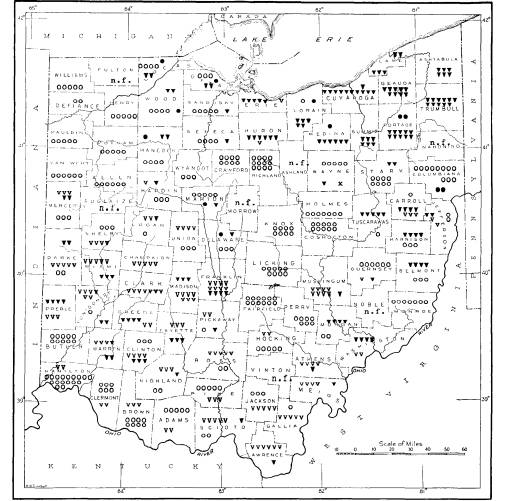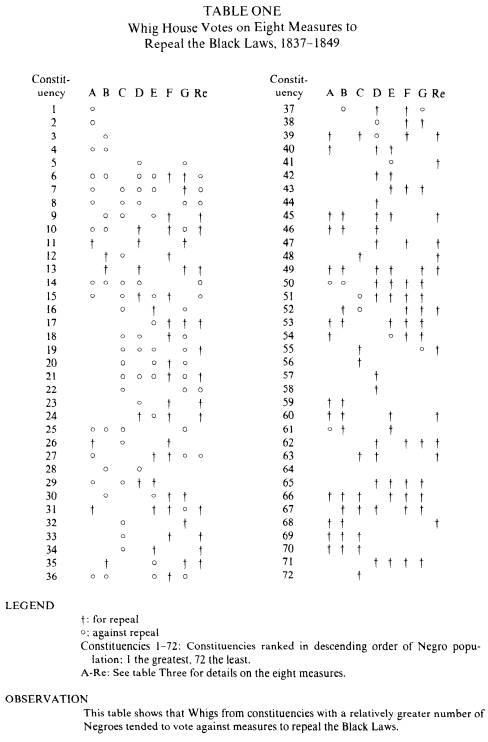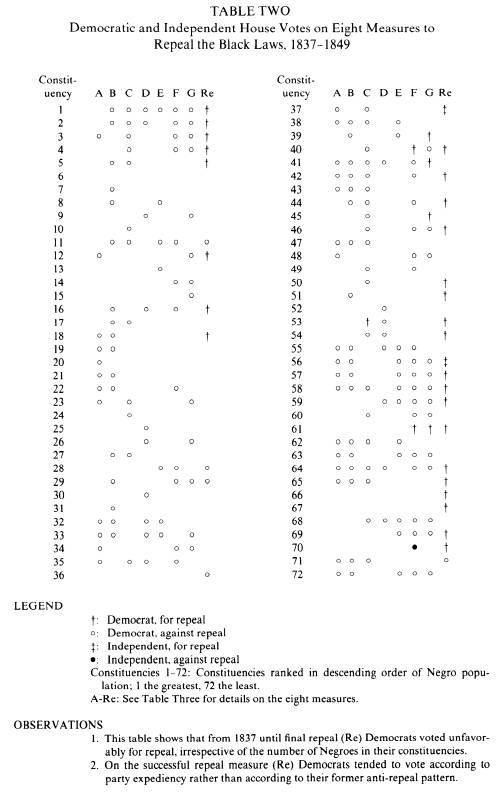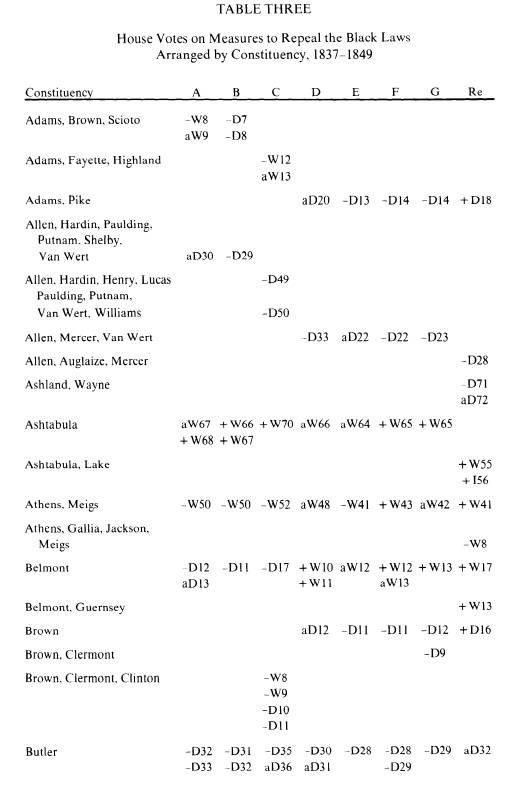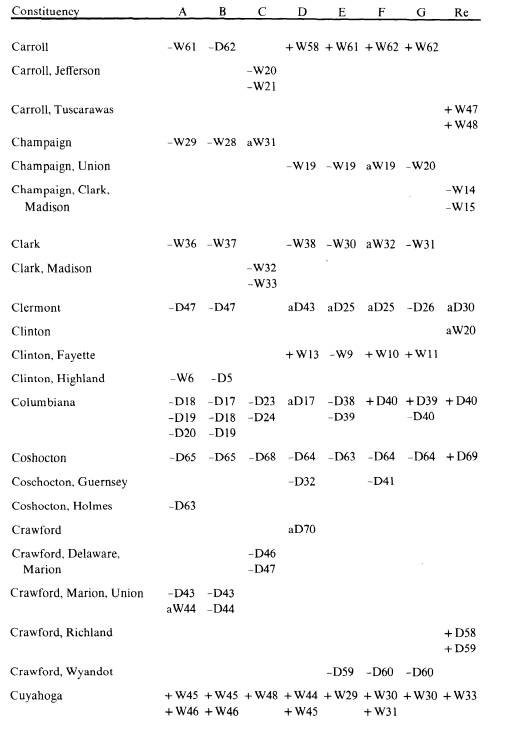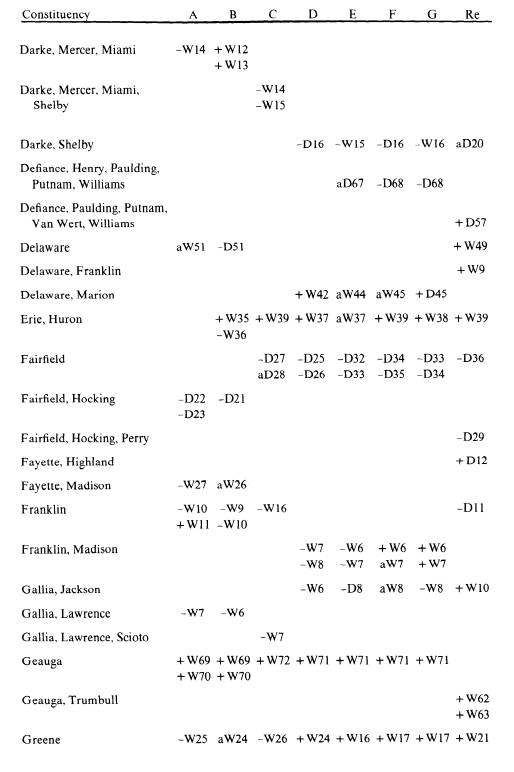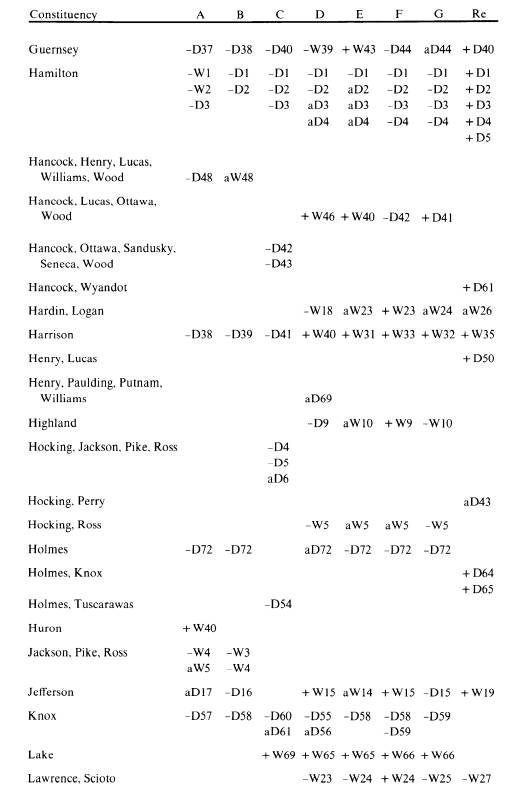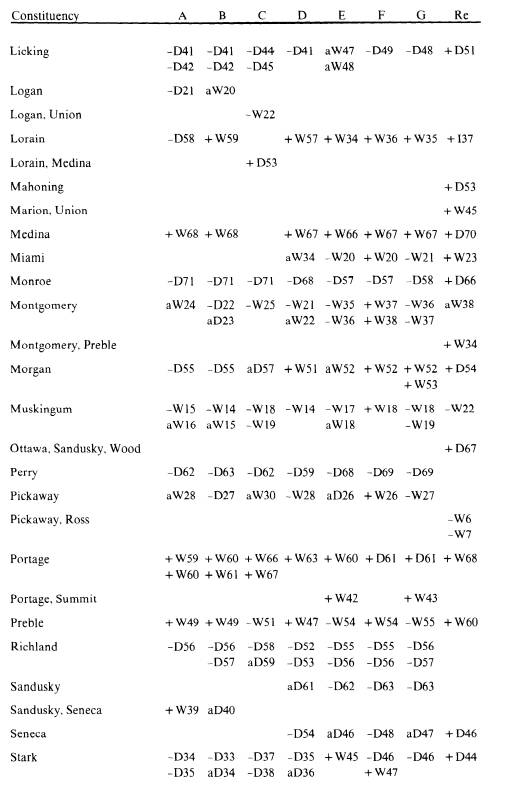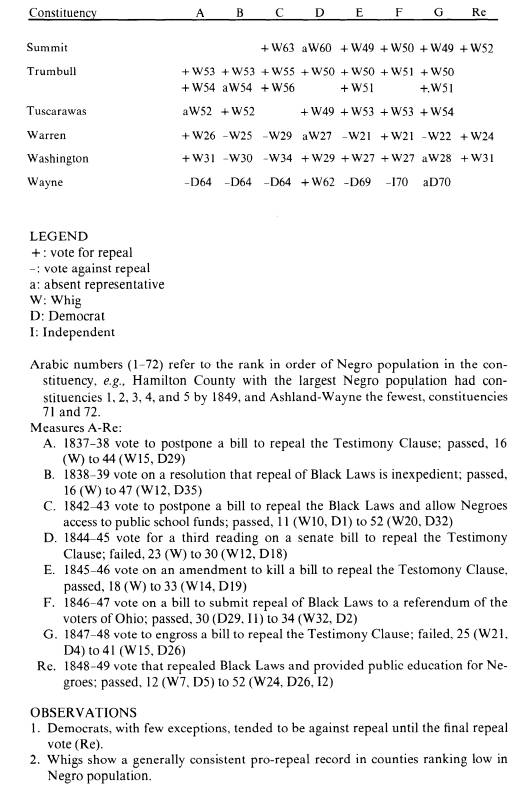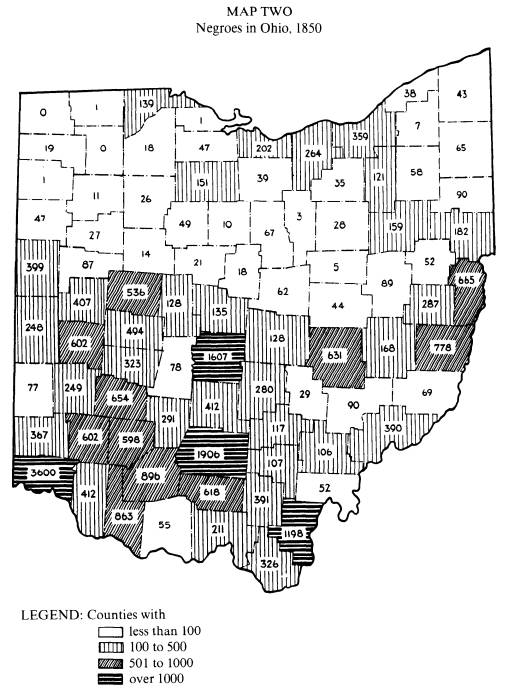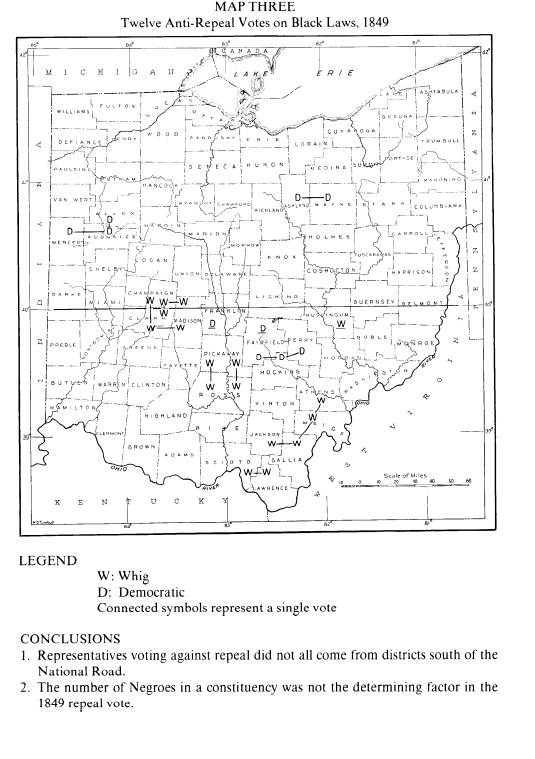Ohio History Journal
- 1
- 2
- 3
- 4
- 5
- 6
- 7
- 8
- 9
- 10
- 11
- 12
- 13
- 14
- 15
- 16
- 17
- 18
- 19
- 20
- 21
- 22
LEONARD ERICKSON
Politics and Repeal of
Ohio's
Black Laws, 1837-1849
During the campaign of 1846 the
Cincinnati Gazette reported that Democratic and
Liberty men viewed the National Road
(40th parallel) as a Mason and Dixon line
across Ohio, as far as the Black Laws
were concerned.' That same year a related
proposition, that a person's attitude
towards these laws varied according to how
many Negroes he had as neighbors, was
voiced by a Whig Representative, T. R.
Stanley from Scioto and Lawrence
counties, when he asked:
Who are those that clamor for the repeal
of this law? Are they those who will be affected by
its repeal? No sir. In all the eleven
counties of the [Western] Reserve, there were, in 1840,
but 592 Negroes. In the single small,
hilly county of Gallia, there were 799; more than one-
third greater than the whole number upon
the Reserve.2
The Black Laws to which these remarks
refer were those of 1804 and 1807. They
required a certificate of freedom and
bond for Negroes migrating into Ohio and for-
bade "black or mulatto"
testimony in court cases where a white was a party. Later,
after the turn of the century, Robert
Chaddock, in his pioneer study of Ohio peo-
ples, repeated the early beliefs when he
argued that the legislators' attitudes, in 1839
at least, respecting repeal of the Black
Laws depended upon the geographical area
represented by the Assemblyman and upon
the numbers of Negroes in his con-
stituency.3 As we shall see,
such an explanation is incomplete.
While the details of the political deal
by which the Black Laws were finally re-
pealed in 1849 have been well recounted
by such contemporaries as A. G. Riddle
and Norton Townshend, the course of
repeal attempts before that date has largely
1. Quoted in Herald and
Philanthropist (Cincinnati), July 29, 1846. An abolitionist paper
elaborated
on the parallel: As far as slavery and
abolition were concerned, it wrote, "Brown county is South Caro-
lina, Hamilton is Louisiana, and Warren,
Mississippi. Columbiana, Trumbull, Ashtabula and Cuya-
hoga, are Pennsylvania, Massachusetts,
Vermont and Connecticut, respectively, and the National road is
Mason and Dixon's Line. "
Anti-Slavery Bugle (Salem), January
31, 1846.
2. Ohio Statesman (Columbus), February 10, 1846.
3. Salmon P. Chase, ed., Statutes of
Ohio and of the Northwestern Territory, ... from 1788 to 1833 ..
(Cincinnati, 1833), I, 393-394,
555-556. In respect to the resolution against repeal in 1839, Chaddock
wrote, "An analysis of this vote
shows that the demand for repeal came from the northern part of the
state where the people did not feel the
evil of the negro's presence. The southern counties were still a
unit as to the wisdom of these
laws." Robert E. Chaddock, Ohio Before 1850; A Study of the Early In-
fluence of Pennsylvania and Southern
Populations in Ohio (New York, 1908),
85.
Mr. Erickson is Professor of History at
Drake University.
154
Black Laws Repeal 155
been neglected.4 This study
will examine these repeal attempts, and by analysis of
votes during the late 1830's and the
1840's show that geography and the density of
Negroes in the representative's
constituency (electoral district) could be factors in
accounting for Whig votes, but not for
those of Democrats, on repeal attempts. The
Democrats were anti-repeal whether they
were from north or south of the National
Road; whether they came from
constituencies with just a few or with hundreds of
Negroes. Because of this consistent
voting record before 1849, Democratic support
of repeal in that year is all the more
incredible and fascinating.
A serious and systematic attempt to
secure the repeal of the Black Laws began
with the rise of militant abolitionism
in Ohio during the mid 1830's. Reformers in
this movement opposed all laws related
to "distinctions on account of color," partic-
ularly the "Testimony Clause"
which forbade Negro testimony in cases where a
white was a party, and they voiced their
opposition through petitions presented to
the General Assembly. Legislative action
which came as a result of this abolitionist
pressure for repeal can be separated
into two phases, dividing at 1844. During the
first phase there was no serious
activity by either the Whigs or the Democrats for re-
peal. In the second, repeal activity was
quickened; and in the wake of disruptive
political activity by abolitionists,
coupled with a waning of morale of the Demo-
cratic party in Ohio, the question of
the propriety of the Black Laws on the statute
books became much more prominent in the
minds of the legislators. While the
bulk of the present study deals with the
second phase, a few words about activity be-
fore 1844 are necessary.
The behavior of both parties before the
election of 1844 must have been dis-
couraging even to the most optimistic
Negro of that day. What friends he had in
the Assembly were Whigs, but by no means
were all Whig representatives friendly.
With a Whig Assembly in 1837-38 that
party could muster a majority of only one
among its members against a motion in
the house to postpone a bill to repeal the
Testimony Clause; and in the senate only
one other Whig, Benjamin Wade, joined
Leicester King in favor of the latter's
proposal to repeal that portion of the school
law excluding blacks and mulattoes.5
In the 1843-44 Assembly the Whigs again
had a majority, and again the repeal of
the Testimony Clause failed; indeed, there
was not even a recorded vote on
postponement. Democrats were even less sympa-
thetic to calls for repeal. In fact
during the 1838-39 Assembly, responding to a re-
port by Leicester King asking for
repeal, they had passed, with some Whig support,
resolutions which censored abolitionist
activities and asserted the propriety of the
4. A. G. Riddle, "Recollections of
the Forty-Seventh General Assembly of Ohio, 1847-48 [1848-1849],"
Magazine of Western History, VI (1887), 341-351; Norton S. Townshend, "The
Forty-Seventh General
Assembly-Comments on Mr. Riddle's
Paper," Magazine of Western History, VI (1887), 623-628; Towns-
hend, "Salmon P. Chase," Ohio
Archaeological and Historical Quarterly, I (1887), 117-118; Townshend
to B. W. Arnett, April 8, 1886, in The
Black Laws! Speech of Hon. B. W. Arnett ... March 10, 1886, pp.
32-33.
5. Ohio, House Journal, 1837-38, p.
696; Ohio, Senate Journal, 1837-38, p. 509; State Journal and Po-
litical Register (Columbus, semi-weekly), February 27, 1838. There is no
official listing of party affilia-
tions of the Assemblymen for this period
in the journal of either house, or elsewhere. Only the counties
of the members are given. Party
newspapers, therefore, were used to determine political affiliation; see
Ohio State Journal and Columbus
Gazette (Columbus, weekly), October
30, 1835, October 21, 1836; Daily
Journal and Register (Columbus), November 30, 1837; Journal and Register (Columbus,
semi-weekly),
October 26, 1838; Ohio State Journal (Columbus,
tri-weekly), October 21, 1843, October 31, 1844, Octo-
ber 21, 1845; Ohio State Journal (Columbus,
daily), December 7, 1846, October 19, 1847, November 30,
1848; Ohio Statesman (Columbus),
October 15, 1842; Cincinnati Gazette, December 8, 1842; Ohio Re-
pository (Canton), October 19, 1843, January 7, 1847; Cleveland Plain
Dealer, October 24, 1848.
156
OHIO HISTORY
Black Laws. Four years later they showed
the same hostility when they unanimously
rejected a repeal bill.6
This first rather dismal phase was not
entirely a time of discouragement for
friends of civil rights since it was the
formative period for abolitionist political
power. During the campaigns of the late
1830's abolitionists questioned candidates
about their stand on repeal and on other
matters of abolitionist concern.7 In the
1840's they formed first the Liberty
party, and then joined others in the Free Soil
party where they constituted a small,
but at times, crucial political force.
What did the appearance of abolitionism
mean for Ohio politics? Editors of
newspapers of the two major parties soon
came to appreciate the importance of the
abolitionist vote to the Whigs. In
analyzing the 1838 election one Whig editor wrote:
"That party [abolitionists] at this
time hold[s] the balance of power in a number of
counties of the State, sufficient to
decide the party complexion of the Legislature."
In 1842, we are told, the Whigs were
defeated by a union of "two hostile interests"
(Democrats and Liberty men), a union
which was brought about "as a result of a
transient sentiment of disgust on the
part of the feebler, because its particular dog-
mas could not be engrafted at once upon
the creed of the Whig party." While the
Whigs did win the election two years
later, the margin of their gubernatorial candi-
date over his Democratic rival was only
1,271. The Liberty nominee polled 8,898
votes. The Whig's small numerical
superiority obviously was precarious. Should
abolitionist voters choose to back
non-Whig candidates, as they had in 1838 and
1842, the Whig party was in trouble.
Probably not inaccurately, the Democratic
Ohio Statesman claimed it was the Whig awareness of this pivotal
Liberty strength
that had brought about Whig repeal activity
in the 1844-45 Assembly. The paper's
editor, Sam Medary, explained: "The
abolitionists, the coons [Whigs] believe, hold
the balance of power in Ohio, and
fearful of defeat without their aid, they now at-
tempt to woo them into their
embraces."8
It probably is not without significance
that during the 1844-45 Assembly two of
the most prominent Whig journals in the
state called for repeal of all or part of the
Black Laws.9 At the same
time, Democrats were being split by differences over cor-
rect banking policy, and their morale
was seriously weakened as they became dis-
pleased with Polk for his handling of
the Oregon Treaty of 1846, his favoring of
southerners in the matter of patronage,
and his veto of harbors legislation which
would have benefitted Ohio.10
In the wake of this erosion of
Democratic morale the Whigs dominated the As-
sembly until the election of 1848 (there
was a tie in the Senate for the 1846-47 ses-
6. Ohio, House Journal, 1838-39, pp.
234-235; 1842-43, p. 859: 1843-44, p. 69, 72, 106, 202: Weekly
Ohio State Journal (Columbus), January 10, 1844.
7. Of course there was some pressure on
Democrats as well as Whigs, especially in such abolitionist
areas as the Western Reserve, but
ordinarily an abolitionist vote withheld or given to the Liberty or Free
Soil parties was a vote lost to the
Whigs. In the 1848 election, only one or two representatives of the Free
Soil party received Democratic
endorsement, compared to five by the Whigs.
8. Ohio State Journal and Register (Columbus,
semi-weekly), October 24, 1838; Weekly Ohio State
Journal (Columbus),
October 19, 1842; Ohio, House Journal, 1844-45, p. 9; Ohio Statesman (Columbus),
March 28, 1845.
9. They were Ohio State Journal and
Cleveland Herald Weekly Ohio State Journal (Columbus), Feb-
ruary 22, 1845; Annals of Cleveland, XXVII
(1844), item 1162.
10. Ohio Statesman (Columbus),
March 30, September 4, 1846; Cleveland Plain Dealer, January 23,
June 14, 1843, January 21, 1848; Francis
P. Weisenburger, The Passing of the Frontier: 1825-1850 (Carl
Wittke, ed., The History of the State
of Ohio, III, Columbus, 1941), 415-440; Eric Foner, "The Wilmot
Proviso Revisited," Journal of
American History, LVI (1969), 271-274.
Black Laws Repeal 157
sion). In this second Whig-dominated
phase activity regarding repeal of the Black
Laws was intensified. The period began
with a near-success. In February 1845
friends of repeal caught their foes with
enough absent members, so the Democrats
claimed, to slip through the senate, by
a vote of 17-16, a bill which would have
amended the Testimony Clause to permit a
Negro to testify provided he could get a
white man to attest to his character.
The opposition was alarmed. The Statesman
saw this as the first step towards
opening the schools to Negroes and encouraging an
influx of them from the South. The
Dayton Empire rang the tocsin:
Are you ready for this state of things?
We appeal to the laboring portion of our fellow coun-
trymen. Are you ready to be placed on a
level with the "niggers" in the political rights for
which your fathers contended? Are you
ready to share with them your hearth and your
house? Are you ready to compete with
them in your daily vocations.11
These fears did not materialize as the
bill failed in the house, where 12 Whigs
joined 18 Democrats to defeat it 30 to
23. So ended the first Assembly of the second
Whig-controlled phase. Later
abolitionist charges of Whig hypocrisy-that they
simply used the promise of repeal to get
votes and then did not deliver-were per-
haps somewhat unfair since what support
repeal did get came almost entirely from
that party. (See Map 1) Yet, undeniably,
enough Whigs did drag their feet on the
whole matter to keep the Black Laws on
the books. In 1846, with substantial major-
ities in both houses (44-28 and 21-15),
they postponed, tabled, recommitted, or
amended to kill bills that would have
repealed all or parts of the laws and permitted
Negroes to use public school funds.12
The Anti-Slavery Bugle was rather sarcastic
about the whole business:
Every body who put faith in the promises
of Whig leaders, anticipated the speedy repeal of
the odious Black code. Action was
however put off from day to day, there were so many
more important things to be attended to-there were dogs to
be taxed and grave-yards to be
protected, Insurance companies to be
chartered and Banking corporations to be defended,
License laws to be re-modelled and
gambling laws to be enaceted, new counties to be erected
and old quarrels to be revived, party
squabbles to be attended to and speeches made for
Buncombe... 13
These were uncomfortable days for
politicians regarding repeal, for obviously nei-
ther major party could satisfy all
sections of the state. Highland County's Represen-
tative Ezekiel Brown's tally sheet for
the house vote in 1845 (on senate bill for repeal
of the Testimony Clause) contained the
notation "dodged" for three Whigs and four
Democrats.14 A Columbus
correspondent of the Anti-Slavery Bugle wrote that the
timidity of the legislators was
incredible, and added, "It is said that men would
rather be knaves than fools."
Considering how emotional people could be about
the Black Laws, it must have taken
courage for Whig nominee, William Bebb, to
run in 1846 with repeal of the Testimony
Clause as a prominent part of his guberna-
torial campaign. There were parts of the
state where this was precarious business.
For example, in Portsmouth a Whig editor
wrote that while he would vote for Bebb
11. Ohio, Senate Journal, 1844-45, pp.
411-416, 450-452, 457-459, 479-483; Weekly Ohio State Journal
(Columbus), February 19, 1845; Ohio
Statesman (Columbus), February 7, 8, 13, 21, 1845.
12. Ohio, House Journal, 1844-45, p.
822; 1845-46, p. 546, 734, 742; Anti-Slavery Bugle (Salem), March
13, 1846; Cincinnati Herald, February
17, 1847; Ohio, Senate Journal, 1845-46, p. 383, 506, 711.
13. Anti-Slavery Bugle (Salem),
February 20, 1846.
14. Tally sheet, VFM 1612, Ezekiel Brown
Papers, Ohio Historical Society.
|
158 OHIO HISTORY
MAP ONE House Votes on Black Laws Repeal Measures, 1837-1848 |
|
LEGEND v: Whig, for repeal v: Whig, against repeal *: Democratic, for repeal o: Democratic, against repeal x: Independent, against repeal n.f.: county not formed by 1848
OBSERVATIONS 1. This map shows that during years 1837 to 1848 geography was not a factor in how Democrats voted on repeal. 2. For the Whigs it shows that the bulk of their opposition came from constituencies south of the National Road (40th parallel), but even below this line there were pockets of votes favorable to repeal. 3. It also shows that the stronghold of Whig support for repeal was in the Western Reserve, the eleven counties in the northeastern section. |
Black Laws Repeal 159
he could not condemn Whig friends who
would refuse to vote for the nominee of
the party, in the light of his repeal
position.15
The Democrats quite naturally looked
forward to a good Whig family brawl on
this issue; but in September they, too,
were drawn into the fray when the Whigs
charged that in 1838 their candidate,
David Tod, had been in favor of Black Laws
repeal. Indeed, they added, he had not
objected to public school funds being used
for Negro education. Whigs subsequently
pictured Tod and his Democratic back-
ers as favoring mixing the schools,
while on his part Tod was busy explaining to
Democrats in Scioto County and elsewhere
that he opposed repeal. In an anti-
repeal section of the state Bebb even
made a last-minute statement that he did not
favor admitting Negroes to jury duty, to
the franchise, or into the common schools,
and that he would prohibit them from
owning real estate. This statement, given in
Mercer County where there was
considerable unrest following an attempt that sum-
mer to settle John Randolph's freedmen
in the area, was made at the last possible
moment so that word of it would not
reach the Reserve in time to change the minds
of abolitionists who had been won over
by his pro-repeal statements earlier in the
campaign.16
In regard to Bebb it must be agreed, as
a Liberty paper argued, that the Whig ex-
cuse for his inconsistency, that he was
speaking for himself and not for other Whigs,
was rather lame, for naturally what the
gubernatorial candidate said appeared to
many to be a party commitment. It would
seem, however, that Bebb's equivocal
position on repeal, at least, was not
damaging since Tod lost by a greater margin
than he had in 1844.17 The campaign of 1846 was the first when
repeal of the Black
Laws was a major statewide issue, and it
appears that abolitionist concern for the
matter could no longer be ignored. Also,
it should be remembered that in even
numbered years during this period the
annually elected Assembly and the governor-
ship were at stake. The party in control
of the statehouse obviously would dispense
the patronage that went with such
control, and in years of presidential elections the
pressure for victory was even greater
since federal patronage was added to the pot.
With these factors in mind, it really is
not surprising that in 1846 Bebb both "fa-
vored" and "opposed"
repeal of the Black Laws and that Whigs attempted to ex-
ploit Democratic divisions regarding
proper party policy, particularly regulatory
legislation for banks, and, on the
national level, the matter of slavery in those terri-
tories that might be acquired as a
result of the Mexican War.
After the new Whig-controlled house
convened in December 1846 (the senate was
tied), the majority members acted on all
the talk of the campaign. But when they
finally did bring forth a repeal bill,
it was rather unheroic-apparently it took some
time to work out a scheme by which
anti-repeal Whigs could pass the buck. After
two bills for repeal had been introduced
in the house, but seemingly going nowhere,
a third was dropped into the hopper
which made repeal contingent on a voter refer-
endum, and passed. The senate did not
concur. Democrats ridiculed the whole
scheme. It called for the election to be
held in the spring when the turnout would
be light. More important, it seemed
absurd for the Whigs to favor a referendum for
this issue involving only a small
portion of the people when they had refused it ear-
15. Anti-Slavery Bugle (Salem),
January 23, 1846; Ohio Statesman (Columbus), September 9, 1846.
16. Ibid., October 7, 9, 1846; Weekly
Ohio State Journal (Columbus), September 16, November 10,
1846; Herald and Philanthropist (Cincinnati),
October 14, 1846.
17. Weekly Ohio State Journal (Columbus),
November 10, 1846; Cincinnati Herald, December 30,
1846; Ohio, House Journal, 1846-47,
p. 18.
160 OHIO HISTORY
lier for revising the state constitution
(expected to favor the Democrats) affecting the
whole population. This attempt to dodge
responsibility was even criticized by the
(Whig) Cincinnati Gazette.18
Abolitionists again rebuked the Whigs
for failure to effect repeal. Such bills
would have passed the senate if they had
been party issues, as were matters of bank-
ing and tariff, wrote the Anti-Slavery
Bugle. "The days of Bebbism cannot last for-
ever," commented the (Liberty)
Cincinnati Herald.19 And then,
ignoring Demo-
cratic opposition to repeal, the paper
said in connection with the senate voting:
All we ask... is that this party shall
come before the world in its own and not in borrowed
dress-that it shall confine its claims
to protection of Manufacturers, and the creation of
money facilities, and disavow all
pretensions to the defence and guardianship of the natural
rights of man ... that it shall not seek
to obtain the suffrages of the people on false pretenses
... it will save their future candidates
the trouble of being all things to all men, and every
voter that supports them will understand
that he is voting for Protection and Paper Money,
and not for the Rights of Humanity.20
Perhaps this abolitionist's displeasure
was in part prompted by the fact that since
the Whigs had majorities on the days
when votes in the senate were cast on bills in-
volving repeal (the house referendum
bill and two senate repeal measures) they
should have delivered. Bills for repeal
or partial repeal were also introduced in the
following Assembly (1847-48), both in
the house and the senate, and with the usual
result. Solid Democratic opposition,
plus substantial Whig help left the Black Laws
intact until the dramatic 1848-49
session.21
It might be appropriate at this point to
set the stage for that dramatic and im-
probable session of the 1848-49
Assembly. House votes on legislation mentioned
thus far will be grouped in such a way
that they may be examined in terms of geog-
raphy (Map I) and the number of Negroes
in the constituencies of the representa-
tives (Tables I, II, III, and Map II).
To help determine whether a representative's
vote was related to the number of
Negroes in his constituency the eight measures
concerning repeal have been arranged in
two tables, one for Whigs and a second for
Democrats and Independents. For each
table the seventy-two electoral districts of
the house are listed in order of the
number of Negroes in those constituencies at the
time of the nearest census-that of 1840
for 1837-38 to 1844-45, and 1850 for the
other Assemblies. For example, Hamilton
County with the greatest number of Ne-
groes was constituencies 1, 2, and 3 for
vote A (1837-38); Holmes County with the
fewest of any constituency was last at
72. The votes on the various measures are
designated A to G, and set apart in a
separate column under "Re" is the repeal vote
of 1849. It is hoped that by this arrangement
the reader can compare more easily the
voting of representatives from those
districts with comparatively numerous Negroes
with those that had only a few. Table
III identifies these votes, or absence of a vote, in
(text continued on page 169)
18. Ibid., 15, 127, 150-151,287,311,359,376,445, 499, 518-525;
Ohio, Senate Journal, 1846-47, p. 613;
Cleveland Plain Dealer, February
8, 1847; Ohio Statesman (Columbus), February 2, 19, 1847.
19. It is not certain which senate vote
distressed the Bugle. Before voting on the house bill, the senate
had already postponed two of its bills
for partial repeal. Ohio, Senate Journal, 1846-47, pp. 342-343;
Anti-Slavery Bugle (Salem), February 5, 12, 1847.
20. Cincinnati Herald, February
17, 1847.
21. Ohio, Senate Journal, 1847-48, p.
42, 409, 506, 516; Ohio, House Journal, 1847-48, p. 62, 222,
455-456.
Black Laws Repeal 169
terms of party affiliation as well as
the county or counties of the representatives.22
Map I shows whether the voting on the
repeal issue before 1849 was related to ge-
ographic area. On this map the votes are
recorded by coded symbols, but the
reader should be cautioned that the
number of symbols does not match the number
of votes. A separate symbol is given for
each vote by each representative in such
counties as Hamilton that had more than
one representative. In multi-county con-
stituencies a symbol is given for each
county in the constituency, even though a
number of counties grouped together in a
single district had but a single representa-
tive and a single vote. It is hoped that
this presentation will show how the political
power of the several counties of the
state was used in respect to repeal, even if the
power of the counties was unequal. To
the degree such use of political power re-
flected public opinion, the map will
show how various areas felt about repeal.
It must also be noted that the data in
Tables I and II are at times approximations.
New counties were formed during this
period and there is no way of knowing just
how many Negroes were lost to each of
the former counties when a new one was
formed.23 For the position in
the tables, in these cases, the author simply averaged
the population over the new counties.
For example, Vinton County had a colored
population of 107 in the 1850 census,
but since it was not formed at the time the
votes after 1845 were cast, the 107 were
divided equally among the five counties
from which Vinton was formed. Map II
shows graphically the density of Negro
population in the various counties in
1850.
Examination of the tables and maps will
show that voting behavior regarding re-
peal was not simply a matter of
geography, as Chaddock implied; nor was racial
prejudice necessarily less where there
were fewer Negroes, at least as far as the vot-
ing during these years was concerned.24
Democrats consistently voted against re-
peal before 1849 regardless of whether
they came from Hamilton County, with the
most numerous blacks, or from Richland
and Wayne counties, which were north of
the National Road and had few Negroes.
Indeed, the Democrats cast only 7 favor-
able votes during the first seven
sessions surveyed; or stated another way, cast 188 of
195 of their votes (96.5%) against
repeal. (See Table III)
Whigs, on the other hand, did give most
of the support for repeal, but by no
means was it popular among the
membership in many parts of the state. From
Table III and Map I it can be seen that
representatives in the northeastern counties
(the Western Reserve) were
overwhelmingly for repeal; while those from south-
central counties (Ross, Pike, Scioto), the Mad River
counties (Champaign, Clark),
and Muskingum to the east were strongly
opposed. Outside of the relatively non-
committal referendum bill of 1846-47
(vote F) there was not a single favorable
Whig vote from such strongholds as
Montgomery, Muskingum, Athens, and Law-
rence counties. Table I shows that only
42 of their positive votes came from the
22. On Table III the constituencies for
all the sessions where votes were considered have been arranged
alphabetically by counties (or by the
first county in a multi-county constituency). All representatives are
accounted for-positive, negative or
absent. A blank spot, e.g., Carroll County on vote C (1842-43),
means the county's representation was
rearranged or reduced for that year. In Carroll's case it was
grouped with Jefferson County. This
particular mode of presentation was used to enable the reader, in
as many instances as possible, to see
the voting pattern of a particular county or grouping of counties over
the period being considered.
23. For the formation of new counties
during this period, see Randolph Downes, "Evolution of Ohio
County Boundaries," Ohio
Archaeological and Historical Quarterly, XXXVI (1927), 340-477.
24. Frank Quillen, in his study of the
nineteenth century Ohio color line, argued that prejudice in-
creased in proportion to the number of
Negroes in an area. The Color Line in Ohio (New York, 1913), 1.
|
DOCUMENTATION: United States Census, 1850, pp. 817-818. A similar map ap- pears in Francis P. Weisenburger, The Passing of the Frontier: 1825-1850 (Colum- bus, 1941), 46. |
|
170 OHIO HISTORY |
Black Laws Repeal 171
first thirty-six constituencies where
most of the Negroes lived. From Table III we
find that outside of the Reserve, Whigs
cast 87 negative votes, which was 56 percent
of all non-Reserve Whig votes. In light
of these figures it is evident that Whigs
fearlessly attacked this restrictive
legislation primarily in the eleven counties of the
Western Reserve.25
Although the votes in the senate were
not used for the tables or maps, the story
there was quite similar. In five
sessions from 1836-37 to 1847-48 there were bills
introduced to repeal all or parts of the
Black Laws. Of the 167 votes cast on five
measures (one from each session) 55 were
positive-all Whig. Of the 55 positive
Whig votes, 24 were cast by senators
from the Reserve. Of the 112 negative votes,
Democrats accounted for 78, and Reserve
Whigs for only 4-all on the first measure
in 1836-37.26
For over a decade, our data show, repeal
was stalled by a hostile combination of
Democrats throughout the state and of
Whigs from more heavily Negro-populated
areas outside the Reserve until 1848,
when some dramatic political developments
took place. By an apportionment law of
that year Hamilton County was split into
five election districts for the house.
Formerly each of the representatives from
Hamilton County had the entire county as
a constituency, and every voter of the
county could vote on each of the
representatives. By the new apportionment law a
Hamilton County voter could vote for
only one representative, the one running in
his district. The intention was to help
the Whig party pick up some seats where
Democrats customarily swept the county.
When the Whigs did indeed win two
seats, their opponents refused to accept
the results. In the dispute that ensued the
Democratic County Clerk issued
certificates of election to five Democrats, while
judges at the polls gave certificates
for two of the five seats to Whig contestants.27 In
such cases it was up to the house to
judge the dispute.
The 1848 presidential election in Ohio
only served to compound the confusion
when the Assembly convened in December.
Once again the Whigs turned to a mil-
itary hero, and this time a slaveholder
as well. The result was that many Reserve
voters, antislavery as they were, became
so disenchanted with General Zachary
Taylor's candidacy that they joined the
new Free Soil party and voted for its candi-
date, Martin Van Buren, though, as one
said, "God knows how bitter the dose is but
everything for the cause." Van
Buren carried half of the counties of the Reserve
and probably cost Taylor the state of
Ohio, which was won by the Democratic can-
didate Lewis Cass.28
It is doubtful that many Free Soilers
expected to carry Ohio for Van Buren, and
they did not. The election for the
General Assembly, however, was another matter,
for when the votes were counted, they
indeed had captured a number of seats and
as a result were a third political force
when the 1848-49 session convened. The
25. For his time Woodson probably had
the best insight about the Black Laws. He did not, however,
differentiate among Ohio Whigs when he
wrote: "Abolitionists, Free Soilers and Whigs fearlessly at-
tacked the laws which kept the Negroes
under legal and economic disabilities." Carter G. Woodson,
"The Negroes of Cincinnati Prior to
the Civil War," Journal of Negro History, I (1916), 16.
26. Ohio, Senate Journal, 1836-37, p.
148; 1844-45, p. 482; 1845-46, p. 711; 1846-47, p. 343;
1847-48,
p. 506. In both senate and house
sessions there were introduced during the later years of this period,
pairs of bills-one to repeal the
Testimony Clause, and a second to repeal the other Black Laws. In such
cases the Testimony Clause vote was used
since it was more important to friends of civil rights for
Negroes.
27. Riddle, "Recollections of the
Forty-Seventh General Assembly," 342.
28. J. M. Root to Giddings, September
13, 1848. Roll 4, Joshua Giddings Papers, Ohio Historical
Society; Weisenburger, Passing of the
Frontier, 468-470.
172
OHIO HISTORY
membership of the new house presented a
host of possibilities for political deals on
the judging of the Hamilton County
returns. Not counting the two contested seats,
there were 32 or 33 Democrats, 29 Whigs,
and 8 or 9 Free Soilers. Of the Free
Soilers, 5 had been endorsed by Whigs
during the campaign, 1 or 2 by Democrats,
and 2 were truly independent in that
they had run against candidates of both major
parties.29 A little addition
will show that if the Free Soilers who had campaigned
with either Whig or Democratic support
voted with the major party that endorsed
them on non-Free Soil matters, the
lineup would be 34 to 34, leaving the two Inde-
pendents with the deciding votes on
questions of organizing the house.
By way of background for understanding
why these Independents and the Demo-
crats voted as they did, it should be
recalled that in 1849, with no prospect of federal
or state patronage to benefit them and
with a growing suspicion of undue southern
influence in national Democratic
circles, Ohio Democrats were not about to pass by
an opportunity to improve their party's
position on the local level. The opportunity
was presented when the two Independents,
John Morse and Norton Townsend,
joined forces with them to capture
control of the legislature. The Democrats se-
cured from the Independents the
necessary votes to elect one of their members as
Speaker of the house and to seat the
Democratic contestants from Hamilton
County. As the other part of the
bargain, Democrats delivered the votes for the
election of a United States Senator of
Free Soil outlook, Salmon Chase, and also for
a better public education law for Negroes
and repeal of the Black Laws.30
In the opening days of the 1848-49
Assembly a number of bills were introduced
which would have repealed all or part of
the Black Laws. It is not certain why of all
the bills Morse's (HB52) was the one
that was pushed to a vote. His measure did
have the directness of repealing all
racial distinction laws, and we know that Chase
was quite anxious that Morse have
something to show for his voting with the Demo-
crats in organizing the house.31
Whatever the reason, Morse's bill passed the house
by a vote of 52-10, with 4 Democrats and
6 Whigs voting against the measure.
Later in the day a Whig and a Democrat,
who one correspondent reported had
locked themselves in the Sergeant at
Arms' room to dodge the vote, appeared, and
with their negative votes the final
count was 52-12. Townshend recalled later that
considerable party pressure was
necessary to secure passage, and he was probably
correct. One Whig reporter wrote,
"One Loco-foco followed another, like a flock of
sheep clearing a barn yard gate. The old
stagehorses from the Reserve sat in mute
astonishment."32
Then the senate had its turn.
Apparently, when the bill was taken up on the floor
29. Riddle listed eight Free Soilers;
Townshend the same ones, plus Hugh Smart, a Democrat from
Highland and Fayette counties.
Examination of the election returns in the Free Soil Banner indicates
that this paper considered Smart to be
of that party. Free Soil Banner (Hamilton), October 24, 1848.
30. See Townshend's accounts in
footnote 4 above. There were other offices elected by the Assembly
that were at stake, but that of Speaker
and U. S. Senator drew the most attention.
Beginning in 1829 blacks and mulattoes
were excluded from benefits of the common school fund. By
a law in 1848 they were allowed to
attend white schools (the regular district schools) in those districts
where there were fewer than twenty Negro
children, provided no protest was filed by a white patron or
taxpayer. In districts with twenty or
more Negro children, separate schools were authorized, and were to
be financed only by tax money on
Negroes. Laws of Ohio, 1828-29, XXVII, 72-73; 1830-31, XXIX, 414;
1837-38, XXXVI, 21; 1847-48, XLVI, 81-83.
31. Ohio, House Journal, 1848-49, p.
40, 46, 114; Ohio, Senate Journal, 1848-49, p. 81; "Letters of
Salmon P. Chase," American
Historical Review, XXXIV (1928-29), 544-545.
32. Ohio, House Journal, 1848-49, p.
197, 198; Western Reserve Chronicle (Warren), February 14,
1849; Townshend, "Comments on Mr.
Riddle's Paper," 625; Scioto Gazette (Chillicothe), January 31,
1849.
Black Laws Repeal 173
there were apprehensions that it would
admit Negro children into any common
school and adults to juries, and so it
was sent to the judiciary committee for study.
The committee reported out amendments
which specifically exempted from any re-
peal action the laws of 1831 regarding
poor relief and exclusion of Negroes from
juries, but the main features of Morse's
measure regarding public education for Ne-
groes and repeal of the Black Laws were
retained. The senate passed the bill, with
the amendments, 23-11, and the house
concurred with the changes.33 Thereafter the
black migrant need no longer post bond
for his Ohio residence, Negroes could tes-
tify in their own behalf, and their
children were in a better position to leave the edu-
cational wilderness.
On January 3, 1849, the Democrats
secured the Speakership of the house for their
party, and on the 26th the two
contestants of their party from Hamilton County
were accorded legitimacy. On January 30,
Morse's bill passed the house, and on
February 6 the senate passed a modified
version which subsequently became the
law of the state. How did Ohio political
circles view this victory for Negro civil
rights? As we have seen two house
members attempted to dodge the vote; others,
in the senate, rather ludicrously
proposed amendments exempting their con-
stituencies. When one examines Table II,
showing Democratic voting on previous
repeal attempts, and then compares this
record with the vote on HB52 (Re), it be-
comes obvious that the repeal vote was
about the ultimate in turnabout for the
Democratic party. One explanation
Democrats gave was that it was time to end the
Whig use of the repeal issue for party
purposes to attract abolitionist support. Per-
haps more than one Democrat agreed with
the Enquirer's correspondent that the
Black Laws were a repressive failure
and, if nothing more than on grounds of expe-
diency, should be repealed.34 Still,
after reviewing the record of Democratic voting
in regard to racial questions, these
explanations seem to have come after the fact.
In any case, this instance of
cooperation by Democratic legislators with abolitionists
appears to have been an aberration. During the year 1854 the Kansas-
Nebraska Act was passed which would
allow slaves to enter those territories where
previously they had been banned. The
reaction against the measure was so strong
that a new antislavery (Republican)
party was formed which became a major politi-
cal power in the state. Now the
abolitionists had an acceptable, if not always
happy, new political home, and neither
the setting nor the disposition for another
Democratic-abolitionist legislative bargain
occurred for the balance of the decade.
To determine where the hardcore
opposition to repeal was located, we should
look at Map III. It shows that for the
house vote on repeal in 1849 there were only
12 negative votes-7 Whigs and 5
Democrats-and that the anti-repeal votes were
not divided from those favorable by a
simple North-South separation; nor did they
have a direct correlation with density
of Negro population. Rather, most negative
votes were cast by representatives from
a narrow band of counties in west-central
33. Western Reserve Chronicle (Warren),
February 14, 1849; Daily Ohio State Journal (Columbus),
February 3, 1849; Ohio Statesman (Columbus),
February 2, 1849; Ohio, Senate Journal, 1848-49, p. 233,
250-251; Ohio, House Journal,
1848-49, pp. 251-253. By this legislation common school trustees could
establish separate schools, if they felt
it expedient, which would be under the jurisdiction of Negro direc-
tors, who would have access to local
taxes of blacks. Better than in 1848, this act required organization
of separate schools where Negroes were
denied admission to the regular common schools. Laws of Ohio,
1848-49, pp. 17-18.
34. Ohio, House Journal, 1848-49, pp.
15-16, 179; Ohio Statesman (Columbus), January 24, February
2, 1849; Adams County Democrat (West
Union), February 14, 1849; Cincinnati Enquirer, February 1,
1849.
Black Laws Repeal 175
and south-southeastern Ohio, and there
were two votes from districts wholly north
of the National Road. The Whigs, judging
from the newspapers, were not vocal
one way or the other on the repeal
victory, but understandably some papers were
somewhat disturbed with Townshend and
Morse for their role in establishing Dem-
ocratic ascendancy in the house.35 For their part Free Soilers, after
congratulating
themselves for being a potent political
force, chastised the Whigs for their pre-
occupation with anti-Townshendism and
for their silence about the glorious event
of repeal. Some persons were unhappy
with the action of the Assembly, but such
discontent did not result in a
reenactment of the Black Laws.36
35. The Cleveland Herald raged:
"It would require an act of Omnipotence to bring Townshend up to
the level of a Judas Iscariot or a
Benedict Arnold, or Morse up to the level of a fool." Annals of Cleve-
land, XXXII (1849), item 1838.
In 1887 Whig Free Soiler A. G. Riddle
and Independent Norton Townshend exchanged views about
whether a deal with the Democrats had
been needed to secure repeal of the Black Laws. (See footnote 4
above) In light of the voting record of
the previous years, it is difficult to agree with Riddle (p. 350) that
the Democrats were ready for repeal by
1849. Chase stated flatly that a bargain was necessary to secure
repeal. Chase to Giddings, July 26,
1849, Roll 4, Giddings Papers. It would appear that the Cleveland
Plain Dealer was historically accurate when it wrote, "Had
Morse and Townshend merged themselves
with the Taylor Whigs . . . this measure
of repeal would have met the same opposition from democrats it
always has...." Cleveland Plain
Dealer, February 3, 1849.
36. Western Reserve Chronicle (Warren),
February 14, 21, 1849; Ohio Standard (Columbus), February
7, 1849; Anti-Slavery Bugle (Salem), August 25,
1849.
LEONARD ERICKSON
Politics and Repeal of
Ohio's
Black Laws, 1837-1849
During the campaign of 1846 the
Cincinnati Gazette reported that Democratic and
Liberty men viewed the National Road
(40th parallel) as a Mason and Dixon line
across Ohio, as far as the Black Laws
were concerned.' That same year a related
proposition, that a person's attitude
towards these laws varied according to how
many Negroes he had as neighbors, was
voiced by a Whig Representative, T. R.
Stanley from Scioto and Lawrence
counties, when he asked:
Who are those that clamor for the repeal
of this law? Are they those who will be affected by
its repeal? No sir. In all the eleven
counties of the [Western] Reserve, there were, in 1840,
but 592 Negroes. In the single small,
hilly county of Gallia, there were 799; more than one-
third greater than the whole number upon
the Reserve.2
The Black Laws to which these remarks
refer were those of 1804 and 1807. They
required a certificate of freedom and
bond for Negroes migrating into Ohio and for-
bade "black or mulatto"
testimony in court cases where a white was a party. Later,
after the turn of the century, Robert
Chaddock, in his pioneer study of Ohio peo-
ples, repeated the early beliefs when he
argued that the legislators' attitudes, in 1839
at least, respecting repeal of the Black
Laws depended upon the geographical area
represented by the Assemblyman and upon
the numbers of Negroes in his con-
stituency.3 As we shall see,
such an explanation is incomplete.
While the details of the political deal
by which the Black Laws were finally re-
pealed in 1849 have been well recounted
by such contemporaries as A. G. Riddle
and Norton Townshend, the course of
repeal attempts before that date has largely
1. Quoted in Herald and
Philanthropist (Cincinnati), July 29, 1846. An abolitionist paper
elaborated
on the parallel: As far as slavery and
abolition were concerned, it wrote, "Brown county is South Caro-
lina, Hamilton is Louisiana, and Warren,
Mississippi. Columbiana, Trumbull, Ashtabula and Cuya-
hoga, are Pennsylvania, Massachusetts,
Vermont and Connecticut, respectively, and the National road is
Mason and Dixon's Line. "
Anti-Slavery Bugle (Salem), January
31, 1846.
2. Ohio Statesman (Columbus), February 10, 1846.
3. Salmon P. Chase, ed., Statutes of
Ohio and of the Northwestern Territory, ... from 1788 to 1833 ..
(Cincinnati, 1833), I, 393-394,
555-556. In respect to the resolution against repeal in 1839, Chaddock
wrote, "An analysis of this vote
shows that the demand for repeal came from the northern part of the
state where the people did not feel the
evil of the negro's presence. The southern counties were still a
unit as to the wisdom of these
laws." Robert E. Chaddock, Ohio Before 1850; A Study of the Early In-
fluence of Pennsylvania and Southern
Populations in Ohio (New York, 1908),
85.
Mr. Erickson is Professor of History at
Drake University.
154
(614) 297-2300
